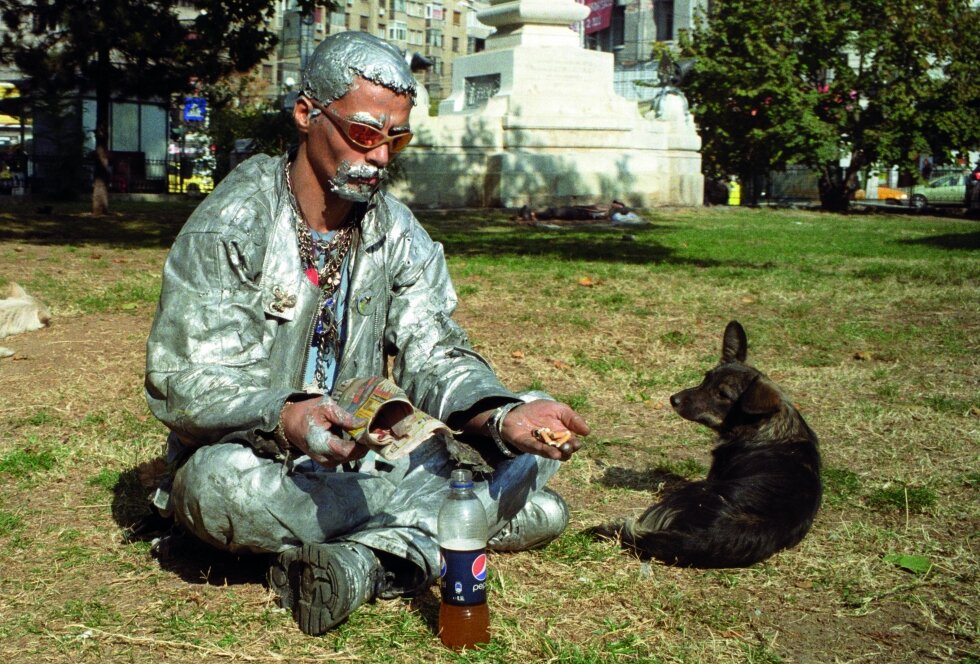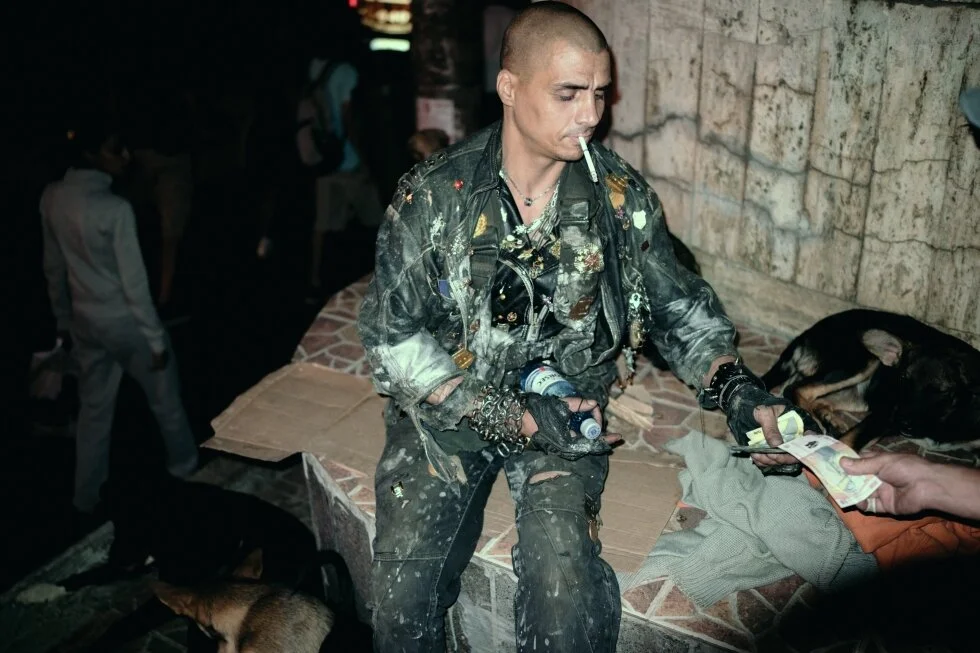Joost Vandebrug / The Lost Boys
Photomonitor UK | September 2016
Joost Vandebrug is a London based art-director, fashion photographer, music video director, documentary photographer and filmmaker, and he also designs children’s clothing.
One of Vandebrug’s most successful projects, which is still ongoing, is The Lost Boys series. Since 2011 he has been following and documenting the lives of a gang of children who call the streets and tunnels of post-communist Bucharest their home. Over 6,000 photographs turned into a book, Cinci Lei, (Five Lei) which he got off the ground thanks to a Kickstarter campaign, and more than 120 hours of footage will soon be film-ready. Currently Vandebrug’s first feature-length documentary Bruce Lee and the Lost Boys is being produced by London based production company Grain Media.
Below, Photomonitor contributor Francesca Marcaccio Hitzeman interviewed Vandebrug about the background to The Lost Boys and plans for the future.
FMH: You are well-known as a fashion photographer and filmmaker; however, The Lost Boys is a completely different project. Most of the photographs of the kids were taken underground in the tunnels (created during the Ceausescu era but shot between 2011 and 2015) in Bucharest, exploring the youth’s complexity and human relations such as friendship and brotherhood. Could you tell us how you first get involved in this project?
JV: Four years ago, at the North train station in Bucharest I met a young boy huffing from his bag of drugs. His name was Costel, he just turned 14. I tried to have a small conversation with him and asked to take his picture. The next day I went to the same spot to find Costel again, this time so I could give him back that picture I had shot of him. For almost a week I repeated this sequence of taking a photo and giving it back, when Costel asked me to see where he lived. This was my introduction to the tunnels under the streets of Bucharest. Over the coming weeks and months, I was introduced to other boys just like Costel: Nicu, Safta, Liviu and Stefan who I later named ‘the Lost Boys’.
FMH: In this project I think there is a very strong statement that places the camera as the most powerful tool ever invented—it is more powerful than any weapon. Its strength comes from empowering people and multiplying their potential. It is a tool that speaks all the languages and can connect its holder with everyone in the world. It is also a tool that enables each person to share their story and their unique point of view. When did you realise that photography was going to be the only tool of communication between you and the boys?
JV: Initially we didn’t share a common language, so photography became my way to communicate with the boys. I also think that by sharing the photographs they felt free to explore who they wanted to be, in front of a benevolent lens. They allowed me to take photos of their lives and also often initiated the photographs themselves. Susan Sontag wrote [On Photography..] that photography has become central to modern family life, to such an extent that parents who fail to take pictures of their children are considered neglectful. In that context, and although the boys are unfamiliar with traditional family life, the experience of being seen positively, through photographs, might have affected them and also helped me gain their trust.
FMH: In several of the photographs the children are accompanied by dogs . The dogs seem to suggest a similar pack mentality demonstrated with the children. They exist in an almost dystopian underground dwelling relying on one another for survival. How would you describe this relationship and how your presence altered that balance?
JV: The dogs are (or were) part of the same pack as the kids and the other homeless: Outcast. Resulting in the children developing an almost parenthood relationship with the dogs. The stray dogs came when back in communism Nicolau Ceausescu asked for the demolition of part of the old housing estates. 40.000 people had to move from those areas into modern apartments towers, many of which did not allow dogs. Thousands of pets were left behind in the process.
In the summer of 2013, the Romanian Parliament passed a law that allowed authorities to kill dogs if not placed in animal shelters, or left without an owner for 14 days. The result was a mass killing of the voiceless animals. To me it once again showed the hasty attitude of the Romanian government, which tries to solve problems without taking in consideration the weakest part of society, a category where the Lost Boys fit in too.
FMH: The Lost Boys Project raises many questions, beginning with how did these boys find each other and what is it that made them a group. How did you first approach photographing the boys? What is your first memory?
JV: The name Cinci Lei translates to Five Lei. ‘Lei’ being the local currency. Even before I took that first photo of Costel, he asked me for ‘Cinci Lei’. This was the first Romanian I learned and I suppose more or less the first memory of the boys. When I started taking pictures of Costel, then Nico, they introduced me to Liviu, Bruce Lee and the other boys which I later named the ‘Lost Boys’. They were protective of me and took me under their wings. The group formed in the early days of the project. I would never have meant to make the Lost Boys, but a friend of mine pointed out that maybe because I named them the Lost Boys, they became the Lost Boys.
FMH: In many ways this project, and the subsequent book entitled Cinci Lei seems to represent the acme of your creative yet intimate journey through the streets of Bucharest. Would you tell us more about how this collaboration with DUST Magazine began?
JV: DUST is a biannual photography magazine about youth related existential themes. It is produced in Berlin and distributed worldwide, and puts emphasis on the awareness of the new generation. Luca and Luigi who run the magazine have been very dedicated towards this project and I’m very happy to be working with them on Cinci Lei.
Together with Luigi and Andrea we have also set up a foundation that helps the kids change their situation for the better: www.cincilei.com
FMH: In the book’s images there is a sense of friendship, family and care. The sometimes distressing images show a surprising side of what we would expect in a narrative such as this; a mutual protection and responsibility that counters a world that has largely forgotten about them. After the first encounter with the boys what is it that made you decide to return?
JV: The moment I set foot in the tunnels, under the streets of Bucharest, I discovered another world inhabited by families, drug addicts, children and many dogs. They showed me their makeshift beds, a kitchen area, a place to wash and the shower. It was the most incredible thing I had ever seen. It even had a christmas tree and decoration during the holidays. On top of all that the people that lived in this underground world had invited me down there, welcomed me and asked me to come back when I left. There was no doubt that I would.
What is interesting is that once the group formed it did not change much, just like my own friendships at home. You make friends and they stick with you, the longer you are together the more valuable that friendship is going to be. It is what this project is mainly about – friendship. It is a coming of age story – kids and their struggle to grow up – something everyone has to do only for these kids their environment is so extreme. By zooming in and focusing on this group, its natural progression was a friendship, and with it the responsibility that ‘friends look out for each other.’
FMH: Childhood usually is something when children feel safe but in your photographs they sort of create this nest where only the dogs are accepted and they appear very exposed. During your time spent with them were there any instances where you felt uncomfortable taking photos?
JV: There was a time when Costel got very upset, up to a point where he wanted to destroy my camera. It came out of nowhere and I didn’t understand it at first. Later I learned that he got very angry with me leaving again. I think he felt stuck and exposed while I had the freedom to go in and out whenever I pleased. This was a very hard time and made me think a lot of what I was really doing there, and whether I wasn’t being hurtful. I still don’t really have an answer to that. But to answer your question, it was definitely not the time to take photos.
FMH: In the past, perhaps gallery exhibitions were the pinnacle for a fine art photographer. Now, there is a push for photographers to make books. You have been through the process. Can you please tell us, in your experience, what is the role of the photographer as publisher?
JV: Initially I published the book because I wanted to raise money for the boys, this turned out to be quite a naive thought as it is very expensive to publish and the margins are low. However, thanks to the book we got a lot of interest from people to put on shows and online articles and also from people in the field of NGOs that helped us setup the framework of the foundation.
FMH: Luigi Vitali, editor of DUST magazine plans to utilise the proceeds from Cinci Lei to lend support to the children using ‘smart, site-specific, and non-invasive interventions.’ What are some examples of this that have been made possible thus far due to your work with these children? Could you recommend any other organisations or funding platforms that people who would like to help this cause could turn to?
JV: The most important thing is to listen and to really understand what the people need that you intend to help. In our case I realised that there already was quite a bit emergency care in place, but the Lost Boys seem to fall through every crack and always landed back on the streets. They were going in and out of orphanages but never had any sort of psychological guidance. Government run orphanages are very harsh, and although offer shelter and food, there is very little help to build some sort of future. Plus the potential abuse in the orphanage, especially when the kids are younger can be very damaging. Once they turn 18, they are dropped and that is that. Cinci Lei project works closely with ‘Association Homeless’ which is run by Raluca who is incredibly dedicated towards the boys (and the dogs!). We recently got a psychologist to help the boys cope and to point them gradually towards a healthy direction. In the future we plan to extend to a larger space where the boys can engage in sports, away from the drugs on the street.
FMH: Do you have any current projects that you are working on that you would like to discuss?
JV: I have set up a kids wear label called Jumping Dog. Inspired on the Lost Boys and 100% of the proceeds will fund the Cinci Lei project.www.jumping-dog.co.uk






